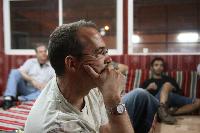Working languages:
Spanish to English
Client-vendor relationship recorded successfully! Nick Harding has been added to your list of hired vendors.
Rate vendor Manage list Nick Harding Always trying to do better! Madrid, Madrid, Spain
Local time : 02:12 CET (GMT+1)
Native in : English
Feedback from 4 positive reviews (2 unidentified)
Your feedback
What Nick Harding is working on Mar 9, 2024 posted via ProZ.com ):...more, + 4 other entries » Total word count: 9770
Always trying to do my best!
Freelance translator and/or interpreter, This person has a SecurePRO™ card. View now.
This person is not affiliated with any business or Blue Board record at ProZ.com.
Translation, MT post-editing, Editing/proofreading, Language instruction, Transcription, Native speaker conversation Specializes in: Finance (general) Investment / Securities Economics Accounting Government / Politics Law (general)
Open to considering volunteer work for registered non-profit organizations Spanish to English - Rates: 0.04 - 0.04 EUR per word / 20 - 20 EUR per hour
PRO-level points: 68 , Questions answered: 50 , Questions asked: 14 2 entriesAccess to Blue Board comments is restricted for non-members. Click the outsourcer name to view the Blue Board record and see options for gaining access to this information.
More
Less
PayPal Sample translations submitted: 2 Spanish to English: Análisis económico financier - © Fundación Acción contra el Hambre General field: Bus/FinancialDetailed field: Business/Commerce (general)Source text - Spanish Análisis económico financier - © Fundación Acción contra el Hambre Translation - English Financial and Economic Analysis - © Fundación Acción contra el Hambre Spanish to English: ESE INCESANTE ZUMBIDO / THAT INCESSANT BUZZING General field: Art/LiteraryDetailed field: Poetry & LiteratureSource text - Spanish Como cada día antes de levantarse, como cada mañana de aquellos últimos 11 años, 3 meses y 7 días, Mikel cogió la foto en blanco y negro que estaba encima de la mesilla, se incorporó ligeramente y la observó con detenimiento. Pasó el dedo sobre la sonrisa tímida de Ainhoa, acarició su mejilla sobre el cristal, y luego sus ojos negros y profundos que miraban directamente a la cámara. Así era ella, profunda y directa. Sincera, como su mirada. Justo detrás, en un segundo plano, Mikel encontró su propia sonrisa, bobalicona e ilusionada, su brazo rodeándola con cariño y una mano sobre el vientre que albergaba aquel niño que nunca nació. Translation - English The same as every day before getting up, every morning during the last 11 years, 3 months and 7 days, Mikel picked up the black and white photo that was on top of the bedside table, sat up slightly and looked at it carefully. He moved his finger over the shy smile of Ainhoa, he caressed her cheek through the glass, then her deep black eyes that were looking directly at the camera. She was like that, deep and direct. Sincere, like her gaze. Just behind, in the background, Mikel found his own smile, grinning and excited, with his arm around her with affection and a hand on her belly which was full of that child who was never born.
More
Less
Banking/Financial Terms 10/01/14 , Humanities 27-04-14 Master's degree - Greenwich University, London. Years of experience: 20. Registered at ProZ.com: May 2012. Became a member: Jun 2013. N/A N/A Microsoft Excel, Microsoft Office Pro, Microsoft Word, Passolo, Powerpoint, Trados Studio English (PDF)
Training sessions attended Nick Harding endorses ProZ.com's Professional Guidelines .
Bio
Hello all,
This user has earned KudoZ points by helping other translators with PRO-level terms. Click point total(s) to see term translations provided. Total pts earned: 68 Top languages (PRO) Spanish to English 40 English to Spanish 28 Top general fields (PRO) Tech/Engineering 20 Bus/Financial 12 Social Sciences 12 Other 8 Marketing 8 Pts in 2 more flds > Top specific fields (PRO) Government / Politics 12 Construction / Civil Engineering 12 Mechanics / Mech Engineering 8 Business/Commerce (general) 4 Medical: Health Care 4 Psychology 4 Automotive / Cars & Trucks 4 Pts in 5 more flds > See all points earned >
This user has reported completing projects in the following job categories, language pairs, and fields. Project History Summary Total projects 3 With client feedback 1 Corroborated 1 100% positive 1 neutral 0 negative 0
Job type Translation 2 Post-editing 1 Language pairs Spanish to English 2 English to Spanish 1 Specialty fields Finance (general) 2 Other fields Slang 1 Law: Contract(s) 1 Tourism & Travel 1
Keywords: Translator, Spanish to English, finance, banking, politics, social sciences, proof reading, revising.
13 visits in the last month,13 visitors Profile last updated

 Member since Jun '13
Member since Jun '13

 positive
positive
